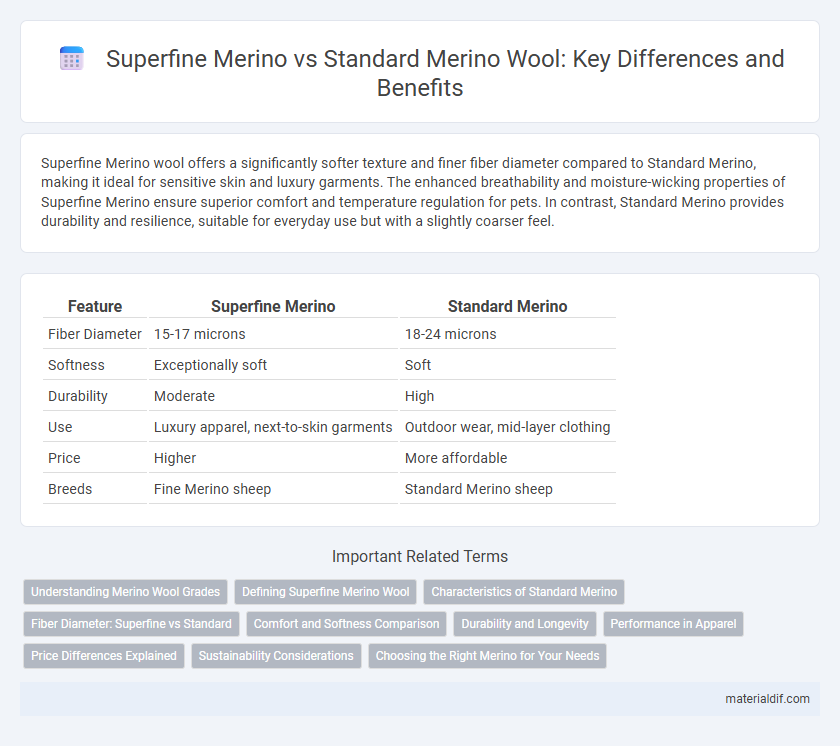Superfine Merino wool offers a significantly softer texture and finer fiber diameter compared to Standard Merino, making it ideal for sensitive skin and luxury garments. The enhanced breathability and moisture-wicking properties of Superfine Merino ensure superior comfort and temperature regulation for pets. In contrast, Standard Merino provides durability and resilience, suitable for everyday use but with a slightly coarser feel.
Table of Comparison
| Feature | Superfine Merino | Standard Merino |
|---|---|---|
| Fiber Diameter | 15-17 microns | 18-24 microns |
| Softness | Exceptionally soft | Soft |
| Durability | Moderate | High |
| Use | Luxury apparel, next-to-skin garments | Outdoor wear, mid-layer clothing |
| Price | Higher | More affordable |
| Breeds | Fine Merino sheep | Standard Merino sheep |
Understanding Merino Wool Grades
Superfine Merino wool features fiber diameters typically under 18.5 microns, providing exceptional softness, breathability, and moisture-wicking properties compared to standard Merino, which ranges from 18.5 to 24 microns. These finer fibers result in higher-quality garments ideal for sensitive skin and performance wear, while standard Merino offers durability and affordability for everyday use.
Defining Superfine Merino Wool
Superfine Merino wool is characterized by its exceptionally fine fiber diameter, typically measuring less than 17.5 microns, which provides superior softness and comfort compared to standard Merino wool that ranges between 18 to 24 microns. This fine micron count enhances breathability and moisture-wicking properties, making superfine Merino ideal for next-to-skin garments. The rarity and quality of superfine fibers contribute to its premium status, durability, and luxury feel in wool textiles.
Characteristics of Standard Merino
Standard Merino wool is characterized by fibers typically measuring between 21 and 24 microns in diameter, making it coarser than Superfine Merino but still softer than many other wools. It offers enhanced durability and resilience, ideal for everyday garments that require both comfort and long-lasting wear. Standard Merino also provides excellent moisture-wicking properties and breathability, suitable for a wide range of climate conditions.
Fiber Diameter: Superfine vs Standard
Superfine Merino wool features an exceptionally fine fiber diameter, typically ranging from 15 to 18 microns, which enhances softness and comfort against the skin. In contrast, Standard Merino wool has a fiber diameter between 19 and 24 microns, resulting in a slightly coarser texture that remains durable and versatile. The finer micron count of Superfine Merino significantly reduces itchiness, making it ideal for high-performance and luxury wool garments.
Comfort and Softness Comparison
Superfine Merino wool delivers exceptional comfort and softness due to its ultra-fine fibers, typically measuring less than 18.5 microns in diameter, which create a smooth, non-itchy texture ideal for sensitive skin. Standard Merino wool, with fiber diameters ranging from 19 to 24 microns, offers warmth and breathability but may feel coarser and less comfortable against the skin. The finer fiber structure of Superfine Merino enhances moisture-wicking and temperature regulation properties, making it a superior choice for premium wool garments prioritizing comfort.
Durability and Longevity
Superfine Merino wool offers exceptional softness and fine fibers but tends to have less durability and shorter longevity compared to Standard Merino, which features coarser fibers providing enhanced strength and resilience. Standard Merino wool is better suited for heavy-use garments due to its greater resistance to pilling and wear over time. While Superfine Merino delivers superior comfort, Standard Merino excels in maintaining structural integrity and extending garment lifespan.
Performance in Apparel
Superfine Merino wool offers superior softness and breathability compared to Standard Merino, enhancing comfort in activewear and base layers. Its finer fibers provide better moisture-wicking properties and temperature regulation, making it ideal for high-performance apparel. Standard Merino, though durable and resilient, is more suitable for everyday wear where extreme softness and lightweight performance are less critical.
Price Differences Explained
Superfine Merino wool typically commands a higher price than Standard Merino due to its finer fiber diameter, usually measuring below 18.5 microns compared to the 19-24 micron range of Standard Merino, which enhances softness and comfort. The production costs for Superfine Merino are elevated because of more selective breeding and harvesting processes that yield a superior fleece quality. Retailers and consumers often justify the increased price with the material's premium feel, durability, and luxury appeal in garments.
Sustainability Considerations
Superfine Merino wool offers enhanced sustainability due to its longer fiber lifespan and reduced need for chemical treatments compared to Standard Merino. Its finer fibers promote greater durability and comfort, resulting in less frequent garment replacement and lower overall environmental impact. Additionally, responsible farming practices often associated with Superfine Merino production contribute to better land management and reduced carbon emissions.
Choosing the Right Merino for Your Needs
Superfine Merino wool, with fiber diameters below 18.5 microns, offers exceptional softness and breathability ideal for sensitive skin and high-performance activewear. Standard Merino, typically ranging from 18.5 to 24 microns, provides greater durability and cost-effectiveness suited for everyday garments and outdoor gear. Selecting the appropriate Merino depends on prioritizing comfort and softness versus longevity and affordability to match your specific apparel requirements.
Superfine Merino vs Standard Merino Infographic

 materialdif.com
materialdif.com